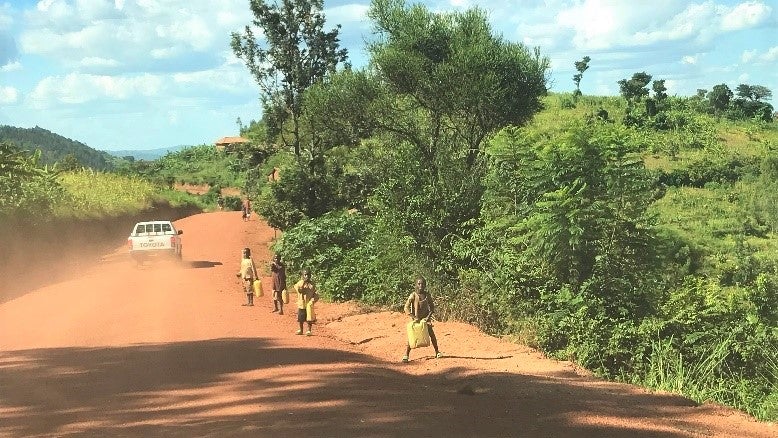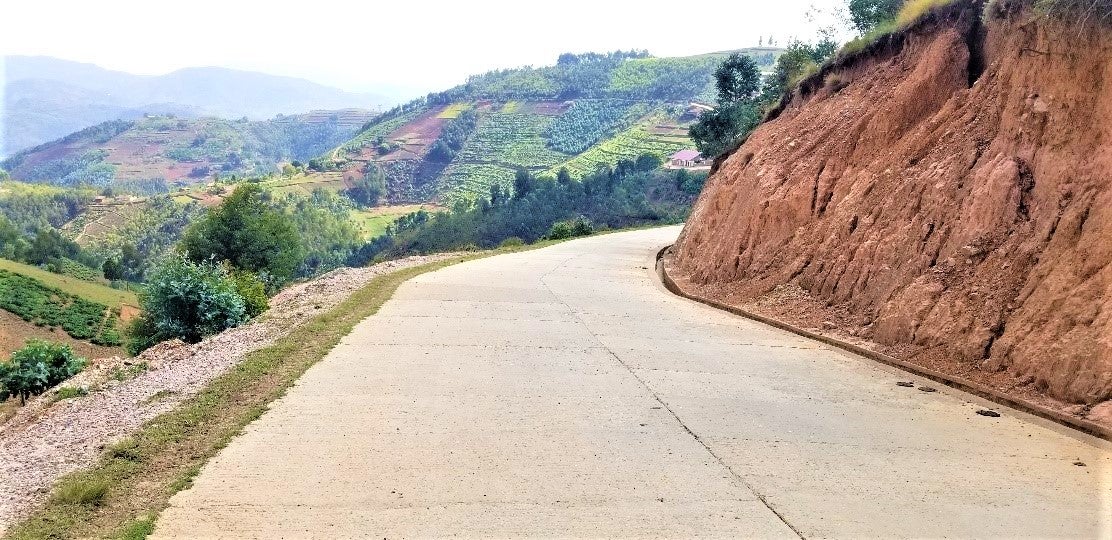 Gravel road in Namibia | © Pierre vincent, Shutterstock
Gravel road in Namibia | © Pierre vincent, Shutterstock
How do decision makers currently make the decision whether to pave a road or not?
Investments in road infrastructure to enhance access and mobility have been an important part of World Bank’s strategy of fighting poverty and increasing shared prosperity since its inception. Bridging Africa’s infrastructure gap is key to overcome the continent’s development challenges. Inadequate road infrastructure retards economic growth potential by undermining the export competitiveness of agricultural produce and other manufactured goods; curtails the opportunity for employment and business development; and impedes human development efforts in health and education.
The difficult task for policy makers, road planners and engineers is to provide roads that meet their functional and structural requirements in a cost-effective way. To do this, the spectrum of options ranges from providing an engineered natural surface, gravel, or low-cost surface treatment, to full paving with asphalt or a concrete pavement surface. Other critical improvements may also be needed for drainage, climate resilience, crossing structures, or road safety enhancements. The standard practice in rural road project evaluation is based on a traditional economic analysis using a discounted comparison of the costs and benefits of paving versus non-paving solutions over the project lifecycle and on the premise that roads will receive adequate maintenance following the initial intervention. Benefits are usually related to travel time and vehicle operating cost savings, which all rely on traffic volumes as the critical underlying factor.
What is wrong with the current approach?
The traditional approach fails to capture important but hard to quantify benefits, and thus biases itself to only recommending roads for paving that have higher traffic levels. It minimizes the importance of other critical factors like climate, materials availability, dust nuisance, land value improvements, the attraction of new businesses, population served, the generation of farm and nonfarm employment, travel comfort, the benefits to nonmotorized transport users, reductions in costs of inputs and goods received, increases in prices of crops and goods produced, and the reliability of the road in the rainy season. As a result, the traditional analysis usually yields regravelling as the solution in most low-volume rural road contexts, since the calculated benefits of travel-time savings and reduced operating costs are not enough to justify the higher costs associated with bringing the road to some form of paved standard. Benefits accruing to non-motorized users are usually not considered making the current approach one that puts the benefit of moving vehicles above the benefits to people residing along these roads, without considering the differentiated opportunities and risks that transport infrastructure and services can bring to women and men based on their mobility patterns.
How does SPADE overcome the traditional shortcomings in the decision to pave?
As many of the road intervention benefits are hard to quantify and are not usually captured in a traditional economic analysis, this leads to the need for a systematic framework for decision making on whether to pave, or not to pave a road. An Africa transport team was assembled with cross-cutting backgrounds, working together to design this innovate Systematic PAving DEcision model - the SPADE model. SPADE considers different variables that affect paving decision in a holistic way, while maintaining an economic justification. By internalizing difficulties to quantify benefits that are normally not considered in conventional methods (climate change, social, gender, equity), this work proposed a paradigm shift that will move us from designing projects based solely on economic evaluations that focus the priorities on the needs of vehicles to a more people-centered approach that caters for the needs of all users and elevates the importance of climate resilience in rural connectivity .
The proposed SPADE model provides a decision framework for paving low volume rural roads, based on a hybrid of Multi-Criteria Analysis (MCA), Cost Benefit Analysis (CBA), and Cost Effectiveness Analysis (CEA), called the SPADE-PLUS approach, which is justified: economically, technically, socially, and environmentally. SPADE-PLUS is a two-stage, sequential approach that combines the SPADE model in Stage 1, and either the Road Economic Decision (RED) model or a CEA in Stage 2.
In Stage 1, the SPADE model incorporates 41 crucial paving decision factors grouped into five categories: country context, regional context, operational environment, road context, and engineering context. Scores are assigned for each of the factors in the SPADE model using the scales provided, with each being noted as normal (single weighting), critical (triple weighting), or super-critical (quintuple weighting). The model then combines the scores from the country context, region context, the operating environment, and road and engineering context for a total weighted score, with scaled percentages of 10 percent, 10 percent, 10 percent, 40 percent and 30 percent being assigned to the buckets respectively. Total weighted scores are thus obtained to generate what is termed a Paving Priority Score (PPS). For a PPS below 50, there is no compelling justification to pave the road under evaluation. The recommendation is “Do nothing,” or explore cost-effective alternatives like spot regravelling, or drainage improvements. For a PPS between 51 and 70, low-cost paving options like chip seals, Otta seals, cobblestones, or similar surfaces should be evaluated. For a PPS between 71 and 100, there is a compelling justification to pave, and the full menu of paving options should be considered.
In Stage 2, for roads that have passed the SPADE prioritization for paving with a medium or high priority rating, an economic analysis is undertaken using either a RED model analysis or a CEA. The proposed bifurcation is to use the RED model for the economic evaluation of higher-traffic roads (>200 Average Annual Daily Traffic (AADT) and a CEA for lower-traffic roads (<200 AADT).
The SPADE-PLUS approach has been calibrated and validated with case studies from six countries in three continents (Ethiopia, Mozambique, Rwanda, and Tanzania in Africa; Laos in Asia; and Nicaragua in South America). An assessment of case studies suggested that traditional approaches tend to overlook critical social, environmental and economic variables that are relevant at the time of paving and more than justify potential upfront additional paving cost. The SPADE model approach yields a higher percentage of roads recommended to be paved compared to traditional approach but still remains robust and defensible since it rejects roads that do not have ample social, economic and other justification. The majority of cases lend themselves to a solution of “medium priority to pave” which means using low cost paving solutions. A small sample of roads have a “high priority to pave” recommendation which allows for all paving options including asphalt and concrete solutions. Some roads despite the new approach would still remain unjustified for paving. Full details are provided in the report.
The SPADE model underscores the need to address climate change considerations and means to better reflect and maximize climate co-benefits , which have a significant impact on how business is run under the rural road infrastructure context. This approach will offer the traditional rural roads delivery a more climate-resilient solution, rather than one based on a flawed assumption that proper maintenance will follow, and roads end up being washed away in the next rainy season.
Roads must be designed and built to withstand the changing climate elements to which they will be exposed over the course of their life cycle.
This approach fills the important knowledge gap in terms of how to overcome the limitations of the traditional cost-benefit economic evaluation approach used in rural road operations in Africa, and elsewhere. The approach is simple, robust, defensible and amenable for application over a wide swathe of countries and local contexts.
There is an enormous value from using this SPADE-PLUS approach in supporting more transparent allocation of resources for paving decisions. By design, the SPADE model balances so many critical paving consideration factors, that can equip road practitioners and transport policy makers with qualitative and policy arguments in support of attracting resources to rural road challenges. It also equips transport practitioners with elements to communicate to non-transport specialists -which in most cases are the ones allocating scare public resources.
Bank teams and client countries working on rural road projects have struggled with the dilemma of whether to pave a road or not, and how to prioritize a given set of roads for investment. They have both always been aware that using the traditional economic tools is insufficient, but not had much recourse to other solutions. The SPADE-PLUS approach provides practitioners with a new tool to prioritize and justify pavement decision using a multi-criteria analysis backed up by economic justification in a systematic, robust and defensible way.
This blog post accompanies the release of the Paving analytical work commissioned by the Africa Vice Presidency, and undertaken by the Africa Transport Unit with inputs from expert consultants and staff. The report: "To pave or not to pave: A systematic framework for decision making in the choice of paving technologies for rural roads" can be downloaded here. The SPADE model developed as part of this work to address the decision-making challenge is also available here, together with the SPADE user manual available here.





Join the Conversation